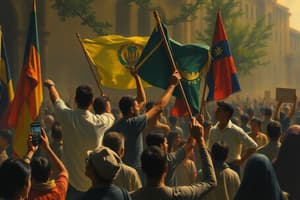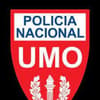Podcast
Questions and Answers
José María Velasco Ibarra fue presidente de Ecuador en cinco períodos diferentes durante el siglo XX.
José María Velasco Ibarra fue presidente de Ecuador en cinco períodos diferentes durante el siglo XX.
False (B)
La Revolución Liberal en Ecuador duró desde 1906 hasta 1912.
La Revolución Liberal en Ecuador duró desde 1906 hasta 1912.
True (A)
León Febres-Cordero Ribadeneyra fue presidente de Ecuador entre 1988 y 1992.
León Febres-Cordero Ribadeneyra fue presidente de Ecuador entre 1988 y 1992.
True (A)
Durante el siglo XX, Ecuador experimentó un clima político estable sin cambios significativos entre democracia y regímenes autoritarios.
Durante el siglo XX, Ecuador experimentó un clima político estable sin cambios significativos entre democracia y regímenes autoritarios.
El partido político Acción Popular (AP) surgió en Ecuador durante la década de 1980.
El partido político Acción Popular (AP) surgió en Ecuador durante la década de 1980.
Jamil Mahuad fue el primer presidente ecuatoriano elegido democráticamente tras la adopción de una nueva constitución en 1998.
Jamil Mahuad fue el primer presidente ecuatoriano elegido democráticamente tras la adopción de una nueva constitución en 1998.
La presidencia de Lucio Gutiérrez (2003-2005) estuvo marcada por un intento fallido de golpe de estado.
La presidencia de Lucio Gutiérrez (2003-2005) estuvo marcada por un intento fallido de golpe de estado.
Rafael Correa, presidente de Ecuador de 2007 a 2017, fue conocido por su orientación derechista y conservadora.
Rafael Correa, presidente de Ecuador de 2007 a 2017, fue conocido por su orientación derechista y conservadora.
La presidencia de Lenín Moreno (2017-2021) se caracterizó por políticas más radicales y un menor énfasis en los derechos humanos.
La presidencia de Lenín Moreno (2017-2021) se caracterizó por políticas más radicales y un menor énfasis en los derechos humanos.
Guillermo Lasso, presidente actual de Ecuador, ha sido criticado por su manejo de la pandemia y su cercanía percibida con la élite empresarial.
Guillermo Lasso, presidente actual de Ecuador, ha sido criticado por su manejo de la pandemia y su cercanía percibida con la élite empresarial.
Flashcards are hidden until you start studying
Study Notes
Ecuador's Recent Journey Through Time
Ecuador, nestled in the heart of South America, has a rich and complex history that spans centuries. While its past encompasses Inca and Spanish colonial eras, this article will delve into the nation's recent history, starting from the 20th century.
The 20th Century: Political Evolution and Struggles
Ecuador's 20th century began with the end of the Liberal Revolution (1906–1912), which ushered in a period of political instability marked by frequent military coups and the rise of populist leaders. By the mid-century, a new generation of progressive leaders, including José María Velasco Ibarra, emerged. Velasco's four-term presidency (1934–1947, 1952–1956, 1960–1961, and 1968–1972) is notable for his ambitious infrastructure projects and progressive reforms. However, Ecuador's political climate continued to oscillate between periods of democracy and authoritarian rule.
In 1972, a military coup led by General Guillermo Rodríguez Lara established a dictatorship that would last until 1979. The return to democracy in the 1980s saw the rise of the political party Acción Popular (AP) and the presidency of León Febres-Cordero Ribadeneyra (1984–1988) and Sixto Durán Ballén (1988–1992). However, economic instability and rampant corruption plagued these administrations.
The 1990s were marked by a wave of democratic reforms and economic liberalization, which included the adoption of a new constitution in 1998 that sought to address long-standing issues of corruption and inequality. Jamil Mahuad, the president from 1998 to 2000, was the first Ecuadorian leader to be democratically elected following the new constitution.
The 21st Century: Political Upheaval and Transformation
The turn of the millennium brought a period of significant political upheaval and transformation. The presidency of Lucio Gutiérrez (2003–2005) was characterized by a failed coup attempt and the country's first impeachment. Gutiérrez's political instability paved the way for the presidency of Alfredo Palacio (2005–2007), who continued the process of addressing Ecuador's economic and political challenges.
The most transformative presidency of this period was that of Rafael Correa (2007–2017), who established himself as a populist and left-leaning leader. Correa's presidency was characterized by significant economic growth, investment in infrastructure and social programs, and the adoption of a new constitution in 2008 that strengthened the powers of the executive branch. However, Correa's administration also faced criticism for its authoritarian tendencies and suppression of political opposition.
The presidency of Lenín Moreno (2017–2021) saw a shift towards more moderate policies and a greater emphasis on human rights and democratic institutions. However, Moreno's administration faced significant challenges, including widespread protests against economic policies and a controversial constitutional reform that limited the powers of the president.
The most recent presidential administration, that of Guillermo Lasso (2021–present), has been characterized by a focus on economic recovery from the COVID-19 pandemic and the promotion of foreign investment. However, Lasso's administration has also faced criticism for its handling of the pandemic and its perceived closeness to the business elite.
Conclusion
Ecuador's recent history has been marked by a series of challenges and transformations. From the rise of populist leaders in the 20th century to the authoritarian rule of Rafael Correa, Ecuador's political landscape has been shaped by the interplay between democracy, authoritarianism, and social and economic reforms. The 21st century has seen a continuation of these trends, with the presidency of Rafael Correa marking a significant turning point in Ecuador's political history.
Despite these challenges, Ecuador continues to face the future with a sense of hope and possibility, as it seeks to address long-standing issues of political and economic inequality while navigating the complexities of globalization and the challenges posed by the COVID-19 pandemic.
Studying That Suits You
Use AI to generate personalized quizzes and flashcards to suit your learning preferences.





